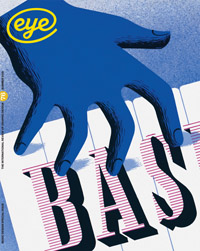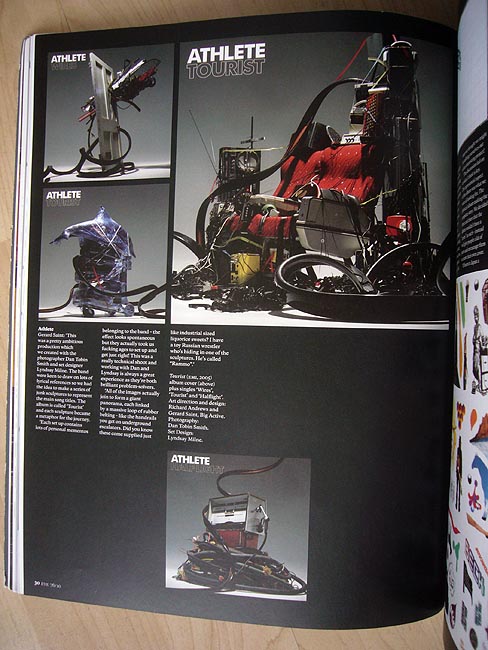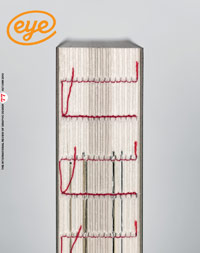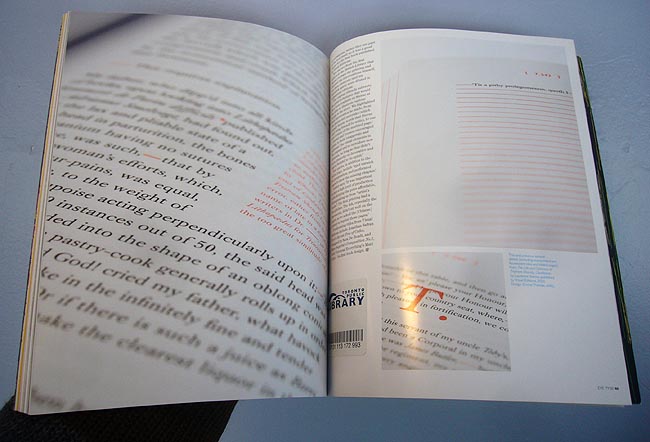The best design magazine ever continues its decline.
Nº 76
 The Music Special Issue achieved the near-impossible: It had almost no articles of interest. (Your £17 well spent?)
The Music Special Issue achieved the near-impossible: It had almost no articles of interest. (Your £17 well spent?)
-
Matthew Carter explains his process of developing a wood typeface, Van Lanen, in an article that would have fared better online if only Eye weren’t clueless about the Web. I suppose if you put the magazine’s online version of the story together with the available Flickr photos you might arrive at a reasonable simulacrum of a legitimate online article.
-
I have no hesitation at all in thanking editor-for-life John L. Walters for his visually ravishing profile of the man who may be the sole visual ravisher in music packaging, Gerard Saint of Big Active. If this guy isn’t a genius, I’m Barney Bubbles.


-
Columbia art director Alex Steinweiss’s constructivist album covers from the ’40s and ’50s are well presented and easy for budding design students to copy. Neville Brody would wear that mantle 40 years later. And I quite liked the way Vaughan Oliver dismantled his own design aura as he described the process of codesigning a Pixies box set. (Typical Eye copy-editing: “[T]hey had no idea of what it could look like. They generally describe it in terms of size: ‘It’s yay high’. ”)
-
Zoë (never Zoe) Street Howe’s piece on heavy-metal umlaut smells like it was cribbed from one of Wikipedia’s most popular articles.
-
The Story of Graphic Design receives a review (by Heller, inevitably) so savage it could be seen as a typical Heller backlash against an author who beat Heller to an original idea. (He’s committed that sin before.) That still may be true, but his criticism of the book is justified.
Nº 77
-
 Andrew Losowsky’s examination of photographers’ evolution toward capturing sound along with images suffers not only from ambiguous British single quotation marks but a pseudo-objective style that betrays the facts of its own topic.
Andrew Losowsky’s examination of photographers’ evolution toward capturing sound along with images suffers not only from ambiguous British single quotation marks but a pseudo-objective style that betrays the facts of its own topic. The lede describes how shooter Joe Weiss decided, of his own initiative, to retrace his steps and conduct interviews (on MiniDisc) at an orphanage where he had previously shot photographs for “a newspaper assignment.”
Losowsky continues for a page and a half in the same vein, featuring photographers and editors who extol the virtues of “audio slideshows” – of which “[a]t one point the [San Jose] Mercury News was producing more than 100… a month.” Which was it? The paper was producing them – or photographers were expected to do well more than twice the work for less than twice the pay? Vincent Laforêt observes: “I don’t know that any publications are ready to help defray any of those costs – in fact, it seems that they want photographers to shoot both stills and video for the same price. That’s not going to be sustainable for anyone.”
Actually, it’s perfectly sustainable for the publications underpaying for twice the work, but that kind of basic economic analysis, built into his subjects’ own statements, is missing from Losowsky’s piece, which pretends that the artistic win of photographers’ spreading their wings into “audio slideshows” and video is enough of an achievement that we don’t have to talk about who pays for it. The article is mostly about newspapers, and it is newspapers that are engaging in a kind of ongoing structural abuse of freelance photographers.
And in any event, half the quotes in the piece seem to be copied and pasted from blogs, E-mails, or both, an ever-spreading deficiency of this ever-lazier magazine and its editor.
I thought it was well established by now that the early-Aughties “converged newsroom” was a fraud.
-
Ten full pages are squandered on reviews of iPad apps – not all of which are related to photography, making them pointless. Then again, so is the idea of reviewing iPad apps in print. Surely this is unlike documenting Web sites and Web development in books, because such documentation is not a review.
The futility of this article was worsened by editor-for-life John L. Walters’s refusal to actually edit bratty “reviews” by the six contributors. (One of those in full: “Football is evil.”) Nor did he bother to rein in their generally unrestrained raves, written in vague press-release English (Danzico: “I nearly couldn’t tear myself away from the magic that is Flipboard to write this review”).
-
Issue 77: Eye’s Greatest Hits.
-
Time for an interview (by starfucker Walters) with somebody who’s already famous. This issue: Paula Scher. I’m sure her large-format graphics, wood-type-like posters, and hand-drawn maps are a complete surprise to anyone who spends £17 an issue on a design magazine.
-
By the same token, we were clearly overdue for an analysis of Penguin book design, this time glossed as a profile of its young art director, David Pearson. (Later, in the book-reviews section, a piece on Puffin by Design.)
-
Then I guess we need a piece about Marian Bantjes.
-
-
John Ridpath’s roundup of artisanal cycling magazines leaves out Dandyhorse. Then again, his topic is on artisanal cycling magazines by designers.
-
Visual Editions’ imprint of Tristram Shandy is given a near-unintelligible photo treatment, with book pages depicted in photographs that are out of focus.

(Article is unbylined, photographer uncredited.)
-
If you were photographing a Chinese replica of this famous building, would you call it “the United States Presidential White House”? And how much would you be paying for a book if its price were listed as “€49.80, chf88”?